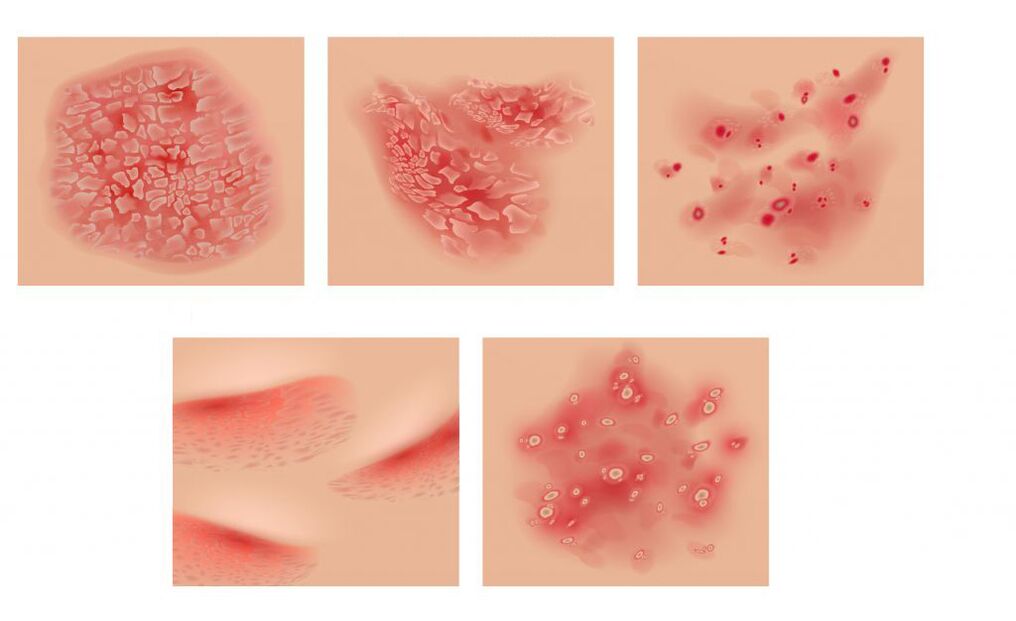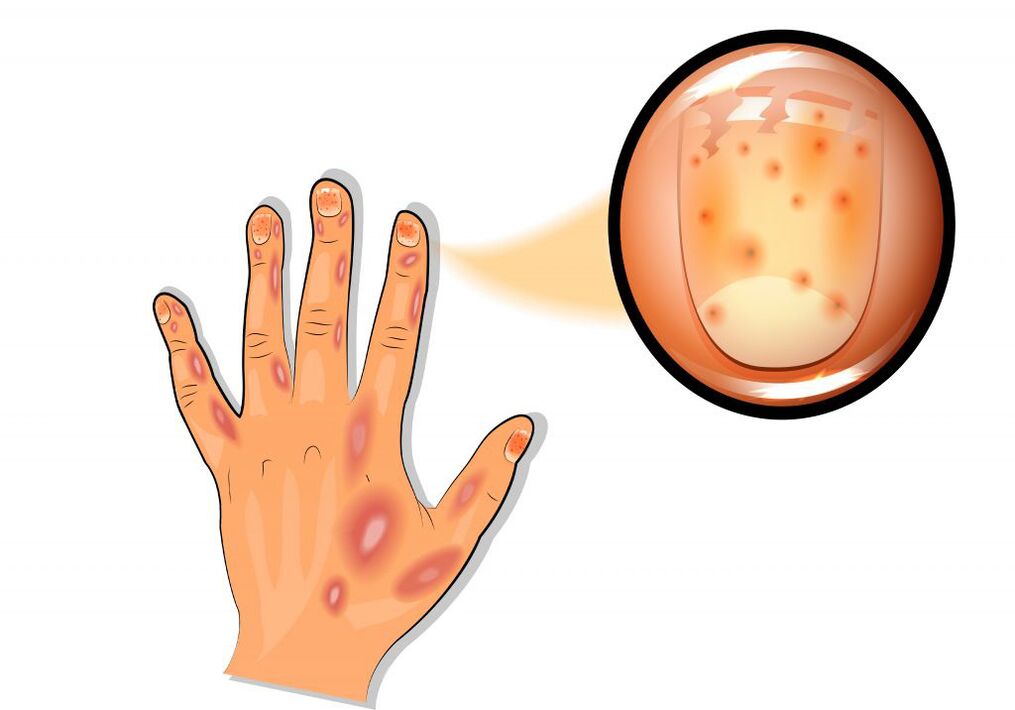Psoriasis: Causes, Symptoms, Diagnosis and Treatment.
Psoriasis is a chronic, non-communicable disease that affects various organs: skin, joints, heart, kidneys.
Most often, mild psoriasis appears on the skin as well-defined pink papules (nodules that rise above the surface of the skin) that coalesce into plaques with silvery white scales.
In moderate and severe disease, inflammatory processes lead to impairment of the musculoskeletal and cardiovascular systems. Psoriasis has a recurrent course (relapse of symptoms after full or partial recovery) and tends to cause comorbidities that impair the patient's quality of life.
Causes of Psoriasis
The disease may be based on several triggers. However, it is still unknown which of them are primary and which are secondary. Immune system dysfunction is thought to be the main cause of psoriasis. Cells designed to destroy the causative agent begin to attack their own cells (mainly the skin). As a result, inflammatory processes develop, leading to accelerated division of epidermal cells (epidermal hyperplasia) and the formation of psoriatic papules and plaques.

Insufficient immune responses are usually due to genetic traits.
Psoriasis is usually inherited.
Currently, more than 40 chromosomal regions have been identified that are associated with psoriasis risk. The onset of the disease may be due to the weakening of the immune system in the context of stress, infectious, endocrine disease. Psoriasis is often accompanied by allergic and immunodeficiency disorders, which are based on a violation of the immune response. Also, certain medications (antidepressants, beta-blockers, NSAIDs) may trigger psoriasis.
Classification of psoriasis
Depending on the localization of the pathological process, various types of psoriasis can be distinguished. Most commonly vulgar, orcommon psoriasisWhen well-defined pink pimples appear on the skin, the pimples coalesce into patches covered with silvery-white scales. If the scalp is damaged (Seborrheic psoriasis), a rash in the form of yellowish scales that descends to the forehead, forming a seborrheic "crown". In patients with metabolic disorders, plaques may develop exudates, a fluid secreted during inflammation.Exudative psoriasis). During childhood and adolescence, especially after streptococcal infection, the condition can become acute with numerous bright red teardrop-like papules on the skin with mild peeling and infiltration.guttate psoriasis). Pustular psoriasis sometimes occurs, characterized by pustules against a background of reddening of the skin, more commonly on the arches or palms of the feet.psoriasis erythrodermaUnder the influence of predisposing factors, it may occur in the context of exacerbation of common psoriasis. Dry white scales cover the skin, which turns bright red, swollen and hot to the touch. run hardSystemic Zumbusch psoriasis. It is characterized by the appearance of small pustules on the red, swollen skin, which merge to form a "pus-pust lake".psoriatic arthritisIt is accompanied by damage to the joints and develops at the same time as the rash or precedes them.

Symptoms of Psoriasis
The cutaneous form of psoriasis is accompanied by the appearance of bright pink punctate papules, sometimes in the form of droplets. When combined, they form patches covered with silvery-white scales.
The rash is located on the extensor surfaces of the arm and knee joints, scalp, lower back, and sacrum.
The top layer of the plaque is formed by scales of dead epidermis that are easily removed. Initially, they occupied the center of the patch, then filled the entire area. When the scales are removed, a shiny bright red surface is revealed. Sometimes the plaque is surrounded by a pink border -- an area of further growth, while the surrounding skin doesn't change. The rash is accompanied by intense itching. With psoriatic erythroderma, patients experience fever (fever with chills) and severe itching, along with a rash on the skin all over the body and increased lymph nodes.
Hair and nails may fall out as the disease progresses over time.
Generalized Zumbusch psoriasis is very difficult. A purulent rash covers the entire skin and is accompanied by severe fever and poisoning. Psoriatic joint damage is characterized by pain and redness of the skin on the surface of the joint. Any movement is difficult and the ligaments and tendons are inflamed. With psoriasis, the nail plate is often affected, and precise depressions appear on the surface of the nail ("thimble" symptoms).

Small, reddish and tan spots (symptoms of "oil spots") appear on the base of the nail plate. Dystrophic changes in nails and hair occur frequently.
In children, especially infants, the symptoms of psoriasis have their own characteristics.
In areas of redness that appear in skin folds, exudate and slight peeling of the upper layers of the epidermis may occur. This picture is similar to diaper rash or candidiasis. Sometimes the rash appears on the facial skin or genital area.
Diagnosis of psoriasis
The disease can be identified by the symptoms of the psoriasis triad (papules with a white, stearic surface; a red, glossy film when the scales are peeled off, and needle-prick bleeding when removed).
Another feature is the Koebner phenomenon. This is due to an erythematous scaly rash (scratches, redness and peeling in the scratched area) after 7-12 days in areas of skin irritation. Sometimes, to confirm the diagnosis, a histological examination of the affected skin area is performed. In addition, clinical and laboratory tests are required: clinical blood tests, biochemical blood tests (total protein, protein fraction, C-reactive protein, ALT, AST, LDH, creatinine, electrolytes: potassium, sodium, chloride, calcium).
Which doctors to contact
If a rash occurs, which usually occurs in the context of infectious disease, skin damage, stress, you should consult a therapist or dermatologist. Referral to an ophthalmologist, endocrinologist, gynecologist, or other specialist is possible if the patient presents with systemic injury.
treat
Psoriasis affects the skin and musculoskeletal system, as well as internal organs. When the rash appears only on the skin, topical glucocorticoid preparations, ointments containing vitamin D3, active zinc, salicylic acid, and synthetic analogues of other ingredients are recommended. Hormone creams should be used with caution for skin prone to shrinkage.
It is necessary to consider that long-term use of steroid creams may lead to hormonal imbalance.
Combined with salicylic acid (a vitamin D analog) to increase the effectiveness of hormone creams. For severe forms of psoriasis, use an acitretin-based second-generation aromatic retinoid. The drug slows the proliferation of epidermal cells, normalizes the process of keratinization, and has an immunomodulatory effect. Phototherapy (UV and PUVA therapy) is also recommended in combination with retinoids. As systemic treatment, doctors may prescribe immunosuppressants. If necessary, prescribe detoxification and desensitization therapy, plasmapheresis.
Complications of psoriasis
Psoriatic arthritis, which affects the joints of the spine, arms, and legs, occurs in 10 percent of patients. The patient suffered from joint pain and morning stiffness. Features of psoriatic arthritis include asymmetry at the site of its presentation, which may be combined with nail damage. Psoriasis is often accompanied by accompanying or comorbid conditions.
Increased risk of coronary heart disease and stroke due to inflammatory vascular disease.
It is also possible to develop diabetes and Crohn's disease. In some cases, complications from psoriasis can lead to disability.
Psoriasis Prevention
Measures to prevent psoriasis are mainly aimed at strengthening the immune system. Skin care should include hydration and nutrition. Due to easy allergy, it is necessary to control nutrition, avoid greasy and spicy food, excessive consumption of carbohydrates, potatoes. A mandatory component of psoriasis prevention should be vitamin therapy.
Furthermore, the functioning of the immune system is largely dependent on the state of the nervous system. People who are conscientious, have busy work schedules, and are constantly affected by negative psychological emotions are more likely to develop autoimmune diseases, including psoriasis. Therefore, psoriasis prevention and physical rehabilitation measures (giving up bad habits, physical exercise) should also provide psychological-emotional comfort.
important!
The information in this section should not be used for self-diagnosis or self-treatment. In cases of worsening pain or other conditions, only the attending physician can prescribe diagnostic tests. For diagnosis and appropriate treatment, you should contact your doctor.























